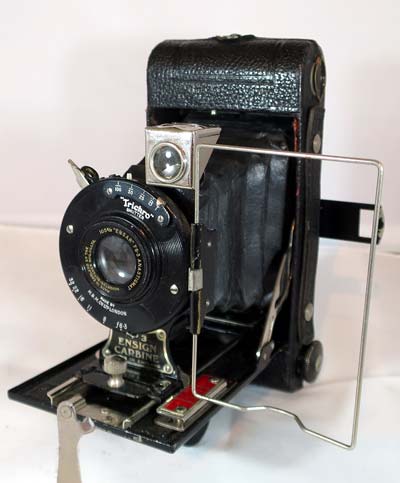Ensign Carbine No.3
Specification

| Manufacturer | : | Houghton-Butcher |
|---|---|---|
| Produced | : | 1930 |
| Classification | : | Medium Format |
| Body Type | : | Folding Bed |
| Bellows Deployment | : | Sliding Rail |
| Construction | : | Metal |
| Film Type | : | 120 |
| Film Width | : | 62mm |
| Image Size | : | 2¼ x 3¼ |
| No. of Images | : | 8 |
| Lens Type | : | Ensar Anastigmat |
| Focus Type | : | Sliding Scale |
| Focal Length | : | 105mm |
| Focal Range | : | 3ft - inf. |
| Aperture Type | : | Iris |
| Apertures | : | f/6.3 - f/32 |
| Shutter Type | : | 5 leaf |
| Shutter Speeds | : | T, B, I(1/25, 1/50, 1/100) |
| Size Open (w x h x d) | : | 80 x 160 x 135 mm |
| Size Closed (w x h x d) | : | 80 x 160 x 32 mm |
| Weight | : | 555g |
Art Deco Credentials
![]()
Limited: Minor and insubstantial
- Produced during the main Art Deco period.
- Chrome detailing throughout
- Embossed rectangle patterns on body material.
- Name plate on bed with Art Deco lettering
Description
This folding bed camera is finished in black imitation leather on the sides but has a black 'crackle' paint finish on the inner face of the folding baseboard. The camera has various chrome embellishments including the struts, viewfinder and the sliding rails on the bed.
Focussing is achieved by sliding the lens board along track to various locking positions, covering 'portrait', 5-9 ft, 9-21ft and beyond 21ft. It is fitted with an Ensar Anastigmat Lens together with a 5 speed shutter including B and T. There is provision for a cable shutter release. It has an aperture controlled by a iris and has a range from f/6.3 to f/32.
Framing is achieved by either using the bright viewfinder attached to the lens board or by using a fold out wire frame in conjunction with a metal eyepiece that slides out from the back of the camera. It has two tripod mount bosses catering for both portait and landscape shots.
It has a cover for the red window which when closed pushes the pressure plate into position.
How to Use
The manual for the camera is found here:- Ensign Carbine No.3 Manual
This camera takes 120 film which is readily available.
If you don't want to bother with an exposure meter, follow the guide shown. It is based on the 'Sunny 16' rule. Film is so forgiving and will produce acceptable results even when overexposed by 2 or 3 stops or underexposed by 1 stop. Number of stops over or under exposure shown in brackets.
Remember that the exposure guide in the camera user manual may not be helpful as it is based on the use of old film with a low ISO value.
The tables assume that the sun is at least 30 degrees above the horizon - that's 10am - 5pm on a summer's day in the UK.
If you are not sure about the light level, err on the side of overexposure - i.e. assume the smaller f number.
Where there is a choice, a larger f number will give a larger depth of field.
For the slower speeds, you may need a tripod to stop blur through shake.
Using ISO 100/125 film
Green=Good Amber=Acceptable
| Weather Conditions | Shadow Detail | Shutter Speed (s) | ||
|---|---|---|---|---|
| 1/25 | 1/50 | 1/100 | ||
 Sunny SunnySnow/Sand | Dark with sharp edges | f/32 (+1) | f/32 | f/22 |
 Sunny Sunny | Distinct | f/32 | f/22 | f/16 |
 Slight Overcast Slight Overcast | Soft around edges | f/22 | f/16 | f/8 |
 Overcast Overcast | Barely visible | f/16 | f/8 | f/6.3 |
 Heavy Overcast Heavy Overcast | None | f/8 | f/6.3 | f/6.3 (-1) |
 Open Shade Open Shade/Sunset | None | f/6.3 | f/6.3 (-1) | - |